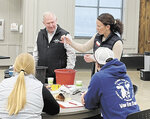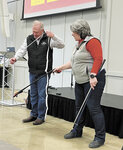

SIOUX CENTER, Iowa — The Iowa State University Extension and Outreach dairy team held a series of workshops that focused on raising dairy heifer calves.
Dairy Days were held Jan. 16 in Elma, Jan. 18 in Elkader, Jan. 23 in Kalona, Jan. 25 in New Vienna and Jan. 30 in Sioux Center.
“The ‘dairy best heifers’ project is a new program funded by ISU Extension,” said Dr. Gail Carpenter. “The point of the project is that raising heifers is very expensive. Dairy operators need to collect data at different points in an animal’s life to help track growth and get a handle on expenses.”
Heifers are often out of sight and out of mind on a dairy farm.
“Heifers can be a black box,” Carpenter said. “You put them where you can fit them. Dairy farmers’ focus is on their lactating cows, which have at least two touch points every day. Raising heifers as an afterthought is not a good way to set up those animals for success. If a heifer starts out behind, it’s impossible for her to catch up.”
Greg Palas, manager of Dairy Records Management Systems support services at ISU, gave a presentation about new management software called Heifer Hub.
“Heifer Hub is a web-based program that is currently being beta tested,” Palas said. “It will integrate seamlessly with Dart and can help dairy operators project future heifer needs and make breeding decisions. You may have to change your breeding philosophy if it appears that you will fall short on heifers. This could include changing the number of breedings that are done with sexed semen or with beef sires.”
Palas also spoke about the KeepOrBeef decision aid.
“KeepOrBeef is a prediction model that calculates the economic value of each cow in the herd,” Palas said. “It shows the relative herd ranking of every cow. It helps answer the question of whether you should sell an animal, breed her to sexed semen or breed her to a beef bull. One goal might be to maximize income from dairy-beef crossbreds. A highly productive herd might choose to use all sexed semen and produce replacement animals that can be sold to other dairies.”
Dr. Jennifer Bentley gave a presentation regarding the costs of raising dairy heifers.
“It costs more to raise heifers now than it did 20 years ago,” Bentley said. “But, we are also feeding our heifers better. Heifers need to meet certain goals such as doubling their birth weight by weaning and calving at 22-23 months of age with an average daily gain of 1.8 pounds.”
The cost for raising a dairy heifer can vary greatly.
“Total costs for raising heifers can range from $2,651 per head in a herd with a 26,000-pound average down to $2,000 for a grass-fed dairy herd that has a 9,000-pound average,” Bentley said.
Grazing growing heifers can help reduce costs.
“You can cut costs by 12%-20% by using a grazing system for your heifers,” Bentley said. “Grazing also results in healthier animals and saves on labor. Heifers that are raised on pasture produce more milk during their first lactation than animals raised in a feedlot. What’s not to like?”
Fred Hall, ISU dairy specialist, echoed Bentley’s remarks.
“Pasturing heifers is a concept that we aren’t using very much here in northwest Iowa,” Hall said. “Grazing heifers isn’t for everyone, but we could be using it more. Labor costs are a big issue on many dairy farms, and there’s a lot of competition for labor in this part of the state. One of our wage competitors, a packing plant in Sioux City, is offering a starting salary of $22.75 per hour with a $4,000 signing bonus.”
Hall stressed the importance of tracking heifers’ growth in every stage of their lives.
“I can’t think of a better investment than a livestock scale for farms that are growing replacement heifers,” Hall said. “When a heifer calves, she should weigh 85% of your herd’s average mature body weight. It’s difficult to track those numbers without a scale.”
Bentley and Dr. Phillip Jardon gave a joint talk about the importance of colostrum management.
“There are five Qs that are crucial to colostrum management,” Jardon said. “They include quality, quantity, quickness, squeaky clean and quantifying. A newborn calf needs to get 10% of her body weight in colostrum within the first two hours of life. For a Holstein calf, that amounts to 3-4 liters. We have found no difference in the performance of calves that were fed colostrum with a bottle versus a stomach tube.”
Bentley said colostrum quality can be affected by many things, including heat stress and the number of days in milk.
“This is why it’s important to measure colostrum quality with a brix meter or some other tool,” Bentley said. “Even though the calf can no longer absorb antibodies after its first 24 hours, it has been shown that there is some benefit to feeding colostrum for up to three days postpartum.”
Every dairy farmer knows about the importance of cleanliness in milk production. The same is true for collecting and storing colostrum.
“The presence of bacteria in colostrum can keep antibodies from being absorbed,” Jardon said. “Bacteria can also cause long-term diseases such as Johne’s and BLV (bovine leukosis virus). Don’t let bacteria sneak into colostrum. Harvest it as cleanly as possible and cool it quickly. Treat colostrum the same as you would milk for human consumption.”
Bentley said all sources of potential bacterial contamination should be located.
“How many surfaces does the colostrum touch on its way to the calf?” Bentley said. “How clean are they? You need to look at gaskets and cleaning brushes along with the usual suspects such as bottles and buckets.”
One weapon in the war against bacterial contamination is an adenosine triphosphate meter, a device that uses light to check for the presence of bacteria on surfaces. Bentley and Jardon gave a demonstration regarding the proper use of an ATP meter.
“We monitored how fast bottles of colostrum cooled in a typical dairy farm’s refrigerator and found that it took well over four hours to get the colostrum down to 40 degrees,” Jardon said. “That’s much too long. It gives bacteria too much of a window. One solution would be to use a dedicated freezer to chill colostrum as quickly as possible.”
Even the highest quality colostrum needs to be warmed to the body temperature of a cow before it is fed to a newborn calf.
“It’s important to warm the colostrum to the proper temperature at feeding,” Jardon said. “Colostrum should be warmed to close to 101 degrees before it’s offered to the calf.”
Comments
No comments on this item Please log in to comment by clicking here